Active Privacy-Preserving, Distributed Edge–Cloud Orchestration–Empowered Smart Residential Mains Energy Disaggregation in Horizontal Federated Learning
Abstract
Combinations of technical advances in artificial intelligence of things (AIoT) are becoming increasingly fundamental constituents of smart houses, buildings, and factories in cities. In smart grids that ensure the resilient delivery of electrical energy to support cities, effective demand-side management (DSM) can alleviate ever-increasing electricity demand from customers in downstream grid sectors. Compared with the traditional intrusive load monitoring (ILM) approach used by energy management systems (EMSs), energy disaggregation, which is an EMS component instead of the ILM approach, can monitor relevant electrical appliances in a nonintrusive manner such that an effective DSM scheme can be achieved. In this study, a distributed horizontal federated learning (HFL)–based energy management framework that implements an active privacy-preserving and edge–cloud collaborative computing–based energy disaggregation algorithm for smart mains energy disaggregation to energy-efficient smart houses/buildings is proposed, and its preliminary implementation, in which active two-stage energy disaggregation considering edge–cloud collaborative computing for autonomous AI modeling is achieved under HFL preserving user data privacy, is demonstrated. In the proposed framework, edge computing that collaborates with the cloud to form edge–cloud computing can serve as converged computing from which load data gathered by distributed on-site edge devices for online load monitoring/smart energy disaggregation are globally consolidated through an artificial intelligence (AI) model in the cloud (cloud AI) and which the model that realizes global knowledge modeling is then deployed for global AI deployment at the edge (edge AI) via global knowledge sharing. In addition, edge–cloud collaboration based on HFL not only improves data privacy and data security but also enhances network traffic, as it exchanges AI model updates (model weights and biases) for global collaborative AI modeling. This is the promising achievement, instead of transmitting raw private real-time data to a centralized cloud server for traditional model training. Simulations are conducted and used to demonstrate the feasibility and effectiveness of the proposed framework for smart mains energy disaggregation as an illustrative application paradigm of the framework; the overall load classification rate can be improved by a maximum of approximately 11% as reported from simulation results.
1. Introduction
Recent state-of-the-art technologies are trending upward in modern society, from fundamental constituents of a city to smart cities that offer improved quality of life by providing intelligent application services based on information and communication technologies to realize smart cities, homes/buildings, factories, and so on [1, 2]. For example, advances in artificial intelligence of things (AIoT), which technically integrates Internet of Things (IoT) technology, comprising information and communications technology, with artificial intelligence (AI) methodology, including machine learning (ML) and deep learning (DL) approaches, for AIoT applications have been developed for resulting novel data insights to turn the concept of a “smart city” from hype to reality. Electricity is a vital resource that supports daily activities and lifestyles in smart cities, where worldwide electric energy consumption is expected to significantly increase over the next few years [3]. A smart grid is one of the AIoT applications. In a smart grid that ensures the resilient delivery of electrical energy to support cities, effective demand-side management (DSM) can alleviate the ever-increasing electricity demand of customers, that is, industrial, commercial, and residential customers, in downstream grid sectors. A DSM scheme implemented in a grid is a type of energy management activity that can effectively promote and mobilize the enthusiasm of consumers to change or transfer their power demand based on dynamic pricing strategies, such as real-time pricing, time-of-use pricing, and inclining block rates [4, 5]. DSM is receiving increasing attention in the residential sector [6]. To achieve DSM, power utilities perform smart meter data analyses, which hold tremendous potential for managing, planning, and optimizing their grid(s) to be upgraded to a smart grid(s). For consumers participating in DSM programs, one way of identifying fine-grained (i.e., appliance-level) electricity consumption is the use of an energy management system (EMS) with intrusive load monitoring (ILM) [7, 8] or energy disaggregation (so-called nonintrusive load monitoring (NILM)) [9, 10]. Considering budget and privacy constraints, the ILM methodology is ruled out because it requires an individual power meter connected to each electrical appliance [9]. Energy disaggregation has been regarded as a significantly more cost-effective and practical alternative for achieving effective DSM, offering the advantages of easy deployment and low investment costs. A comparative summary of energy disaggregation compared to ILM can be found in [8, 11].
The basic concept behind energy disaggregation is that a load monitoring system in the form of an energy meter, a smart minimal set of voltage and current sensors, or other sensing technology in a practical field of interest separates aggregated circuit-level load data (e.g., smart meter data) into individual appliance-level load data, minimizing investment costs including installation and annual maintenance costs. In the literature, such as [12–15] and [16], energy disaggregation was developed under a centralized cloud-centered/stand-alone framework. For example, in [14], the work focuses on presenting a new integrated AI model based on a deep convolutional network combined with the scattering transform for NILM whose hardware implementation is a centralized/stand-alone implementation. The model presented in the work is new; however, it can work better for single loads but can work with a limited detection performance level for two and three aggregated loads. Also, in [15], a few-shot learning NILM algorithm based on voltage–current trajectory features is proposed and used. The algorithm proposed in [15] is a centralized/stand-alone implementation. Lastly, in [16], the author focused on developing a trainingless multiobjective evolutionary computing (i.e., genetic algorithm)–based NILM method that does not necessitate training and retraining stages of the AI model with a hyperparameter tuning procedure for load modeling. The method developed in [16] is also a centralized/stand-alone implementation. With energy disaggregation, an alternative to the ILM methodology, the practical applicability of, for example, home EMSs (HEMSs) can be enhanced for residential energy management in achieving effective residential DSM [1, 10, 17–19] and other applications [7, 20–22]. For instance, in [7], for the daily life activity recognition application, a novel framework named ApplianceNet, whose basic concept behind appliance modeling for daily life activity recognition is based on energy consumption patterns of home appliances equipped with smart plugs, was proposed; however, the framework does not monitor home appliances nonintrusively and does not possess an edge–cloud computing paradigm. Such centralized cloud-centered/stand-alone frameworks for energy disaggregation/NILM as one of the AIoT applications pose significant challenges to the cloud in terms of high network latency and congestion [23] induced by heavy communication burdens. In addition, limited by network connectivity (i.e., the Internet connectivity is limited or not always available), transmitting all of the local load data as IoT data from the edge side to the cloud side for AI modeling is no longer suitable for the application paradigm.
Edge computing, which is a feasible complement of cloud computing to form edge–cloud computing, can perform real-time/on-site IoT data analysis at the edge of the network, thus alleviating high network latency and congestion [23]. It can be conducted for the development of energy disaggregation. In this regard, in [9], an energy disaggregation approach based on an event-driven factorial hidden Markov model was implemented in an edge–cloud computing framework, where data-intensive event detection was performed at the edge side and model-intensive load disaggregation was completed at the cloud side (the cloud server took over the task of load disaggregation). Although the implemented energy disaggregation approach is novel in that multiple edge devices bridge the gap between the IoT end nodes and the cloud infrastructure, the online load disaggregation process is terminated when Internet connectivity is unavailable. As expected, this problem can be tackled through a dedicated edge–cloud collaborative computing scheme. The data-intensive event detection method developed in [9] is improved in [24]; the features extracted through the robust event detection method in [24] can improve the energy disaggregation approach implemented in [9]. As stated before, energy disaggregation is an alternative to the ILM methodology, which can enhance the practical applicability of HEMSs for achieving, for instance, effective residential DSM. In addition, it can be dedicated in edge–cloud collaborative computing. As a result, as expected, the work reported in [18, 19] can be advanced by energy disaggregation for the practical realization of effective residential DSM, which can be conducted and used to nonintrusively model relevant electrical appliances so that their related characteristics can be identified for power scheduling. Moreover, as expected, the work reported in [19] can also be advanced via edge–cloud collaborative computing. Different from the work reported in [18], the work reported in [19] is a multiagent-based decentralized residential energy management framework utilizing deep reinforcement learning.
In energy disaggregation, most energy disaggregation models cannot identify unknown new/latent appliances correctly when they exist with appliance usage in their load monitoring environment, as the models inevitably misclassify appliance samples of an unknown class: Appliance samples are classified as one of the known appliance classes. To this end, active learning, one of the ways to tackle such an energy disaggregation problem, is a modern paradigm in AI, which can be applied to energy disaggregation considering the identification of unknown loads. In [25], an active learning–based framework, a centralized cloud-centered/stand-alone framework, was proposed for the achievement of model-based low-frequency energy disaggregation, rather than the achievement of high-frequency event-based energy disaggregation that relies on unrealistic perfect event detection [26]. In [25], a more realistic scenario, in which models can adapt to new environments with unknown data distributions where labeled data are unavailable, is considered and used to evaluate the proposed framework. However, the framework proposed in [25] is a centralized cloud-centered/stand-alone framework, and it is not proposed under an edge–cloud collaborative computing paradigm. Additionally, data security and privacy concerns are not addressed in the framework (as indicated in [27], in the context of smart homes, security is mostly related to data security and privacy of smart-home data and to the guarantee of the privacy of inhabitants). In [15], the algorithm proposed in a centralized/stand-alone implementation as surveyed previously is innovative for addressing the energy disaggregation problem in which “it is necessary to propose an algorithm that needs merely a small amount of labeled data for identifying newly added appliances and does not necessitate retraining.” Nevertheless, the algorithm cannot determine, autonomously/interactively, specific appliance types of newly added appliances with minimal user intervention for data (re)labeling. This problem can be solved via a dedicated active learning–based energy disaggregation approach, as expected. The energy disaggregation algorithm proposed in [15] is not proposed under data privacy preservation. The study conducted in [28] investigates the effect of nontargeted, unlabeled appliances on the NILM performance of multilabel load classification, where a significant moderate linear correlation between the performance impact and the overlapping coefficient of power distributions of targeted and nontargeted appliances is found. The energy disaggregation algorithm studied in [28] is also not studied in the consideration of data privacy preservation.
As discussed so far, the development of energy disaggregation/NILM methodologies that can autonomously/interactively determine specific appliance types of unknown new/latent appliances with minimal user intervention for appliance (re)labeling and (re)modeling in edge–cloud collaborative computing is one research gap to be fulfilled in the research field. Another research gap to be fulfilled in the research field is the energy disaggregation methodology developed under data privacy preservation. Energy disaggregation under data privacy preservation is reviewed below.
In the context of limited data communication and computing resources and encountered risk of power consumer privacy breaches, there is an urgent need for effective data compression as data privacy protection for implementing energy disaggregation [29, 30]. The work presented in [30] focuses on investigating a data privacy protection approach based on a lossy compression methodology applied to power data in energy disaggregation. In the work, for lossy power data compression for load identification from power data in energy disaggregation, a load power fluctuation segment location method based on a voice activity detection algorithm is proposed, which is combined with a load event detection method that can divide load data into event segments, fluctuation segments, and steady-state segments to be compressed and reconstructed for online smart meter data compression and reconstruction in a divide-and-conquer framework, such that the volume of data transmitted to the cloud server can be reduced (for the event segments, the original data values are retained). Especially, in the framework, for the fluctuation segments, a cloud-device collaborative adaptive fluctuation data compression and reconstruction strategy based on the compressive sensing theory is designed. Similar to the research in [29] indicating that the risk of power consumer privacy breaches may be encountered by local data owners that train an energy disaggregation/NILM ML from massive load data containing different types of appliances, the research in [31] points out that modern ML-/DL-based NILM models cannot succeed without an access to a large amount of independent and identically distributed (IID) training data at the client side, which causes severe concerns on data security and privacy. With regard to NILM considering data privacy preservation based on a collaborative model training paradigm across multiple client entities, in [29], an NILM approach based on a standard horizontal federated learning (HFL) is proposed, which is called FedNILM. FL offers a way of facilitating data knowledge sharing and modeling while preserving data privacy by keeping private data on distributed devices used locally to collaboratively update a global AI model through aggregations of local AI models [32]. In comparison with centrally trained NILM, the FedNILM algorithm in [29] can improve the comodeling capability of local data owners (power consumers) while protecting their data privacy. In [31], a FedNILM algorithm is presented; the training data scarcity with the secured transferability at the edge is addressed by transfer learning combined with standard (H)FL. In [33], an NILM approach based on a distributed and privacy-preserving NILM (named DP2-NILM) framework is developed, which makes the first attempt to conduct FL-based NILM focusing on exploring the utility optimization (tackling high heterogeneity in federated networks) and privacy-preserving (FL at local and global differential privacy levels) schemes in different FL-based NILM application scenarios. Recent reviews of energy disaggregation regarding publicly available datasets, feature engineering methods, user data privacy challenges, and state-of-the-art AI paradigms such as FL have been presented in [27, 34–36]. The NILM approaches based on either a data compression methodology [30] or a collaborative model training paradigm [29, 31, 33] for user data privacy protection are innovative. However, their limitation that needs to be overcome is the scheme being capable of autonomously/interactively (re)modeling a global AI model for specific types of unknown new/latent appliances with minimal user intervention. In addition, it is based on edge–cloud collaborative computing to adapt to load monitoring environments for improved distributed NILM/energy disaggregation.
In summary, as surveyed above alongside the currency of the research subject of energy disaggregation, energy disaggregation based on an active privacy-preserving and distributed edge–cloud collaborative computing–based AI tactic that addresses the two research gaps has not been studied. The energy disaggregation approaches in the literature (Refs. [7–16, 20–22, 25, 28–32]) can contribute to the research subject. Nevertheless, they neglect to develop the energy disaggregation approach based on such an AI tactic in an edge–cloud computing framework (as indicated in [19], FL that can preserve data security and privacy of consumer energy data will make the learning environment fully distributed, reducing the computational complexity of the framework). Therefore, this study develops a distributed energy management framework based on an active privacy-preserving and edge–cloud collaborative computing–based AI mechanism for achieving smart mains energy disaggregation at the edge across multiple fields of interest to be nonintrusively monitored and leveraged. Additionally, a preliminary implementation of the framework implementing the smart energy disaggregation application is demonstrated. FL, especially HFL, is a burgeoning AI learning paradigm that presents a possible solution for collaboratively training a global AI model without the need for storing private data on a centralized server (i.e., the cloud for data transferred from edge clients), thus addressing data security and privacy concerns. The present work is referred to as active federated NILM (Active FedNILM). In the developed framework, by cooperating with the cloud to achieve consolidated global AI in an edge–cloud collaborative computing fashion, the edge computing paradigm with improved performance provides converged computing at the edge, through which local private sensory load data gathered from distributed on-site autonomous edge devices are leveraged through global AI in HFL. The model, global AI, which achieves global knowledge modeling in HFL, is deployed as global knowledge sharing, from the cloud to the edge, on the distributed remote on-site autonomous edge devices for online load monitoring/smart energy disaggregation (the cloud with the drawbacks to be tackled by the edge is based on Internet connectivity that is limited or is not always available). In the developed framework, the advantages of edge–cloud computing increase the significance of the edge. First, the edge collaborates with the cloud to design and implement an innovative energy management application paradigm. Second, the cloud interacts with the edge, distributed on-site edge devices, to be assisted in leveraging local (private) data (under privacy preservation) such that a global AI model to be remotely deployed for edge AI can be developed for the paradigm (active privacy-preserving distributed energy disaggregation over edge–cloud orchestration across multiple fields of interest). Table 1 summarizes the major differences between the present work and the related work in the literature.
| ILM | NILM! | Centralized/stand-alone framework (cloud computing) | Distributed framework (edge–cloud computing)! | Active privacy-preserving edge–cloud collaboration! | |
|---|---|---|---|---|---|
| [7] | ✓ | ✓ | |||
| [8] | ✓ | ✓ | |||
| [9, 24] | ✓ | ✓ | |||
| [12] | ✓ | ✓ | |||
| [13] | ✓ | ✓ | |||
| [14] | ✓ | ✓ | |||
| [15] | ✓ | ✓ | ⍻ (few-shot learning for an energy disaggregation algorithm needing merely a small amount of labeled data for identifying newly added appliances (it cannot determine, autonomously/interactively, specific appliance types of newly added appliances, with minimal user intervention for data (re)labeling, for energy disaggregation under data privacy preservation)) | ||
| [10, 16, 20, 21, 37] | ✓ | ✓ | |||
| [22] | ✓ | ✓ | |||
| [25] | ✓ | ✓ | ⍻ (active learning) | ||
| [28] | ✓ | ⍻ (a significant correlation is established between the performance impact of multilabel NILM and the overlapping coefficient of power distributions of labeled and unlabeled appliances) | |||
| [29] (FedNILM) | ✓ | ✓ | ⍻ (utilizing standard (H)FL to improve the comodeling capability of local data owners (power consumers) while protecting their data privacy) | ||
| [30] | ✓ (lossy power data compression) | ✓ | ⍻ (focusing on the cloud-device collaborative lossy power data compression methodology for NILM) | ||
| [31] (FedNILM) | ✓ | ✓ | ⍻ (the training data scarcity with the secured transferability at the edge is addressed by a transfer learning–combined (H)FL algorithm) | ||
| [33] | ✓ | ✓ | ⍻ (focusing on exploring the utility optimization (tackling high heterogeneity in federated networks) and privacy-preserving (FL at local and global differential privacy levels) schemes in different FL-based NILM application scenarios) | ||
| The present work (Active FedNILM) | ✓ | ✓ | ✓ (Energy AI is empowered by active edge–cloud collaboration under HFL; the collaborativeness enables the model to adapt to load monitoring environments for improved distributed NILM) (active learning integrated with (H)FL is used as an alternative to address the training data scarcity with the secured transferability at the edge) |
- !needing a preliminary stage of energy disaggregation, which is as a limited utilization, from aspects of grid-level applications based on effective DSM, of installed smart plugs in fields of interest to be leveraged such that the applicability/progress of energy disaggregation, as “pseudomeasurements,” in smart grid management and optimization based on effective DSM can be improved/accelerated.
- •
A new distributed energy disaggregation approach based on active learning is developed and established over an edge (fog)–cloud computing framework for a smart (home) energy management application.
- •
A privacy-preserving edge–cloud collaboration mechanism based on HFL for active distributed energy disaggregation across multiple fields of interest is investigated through the framework. The newly developed distributed energy disaggregation approach is a two-stage energy disaggregation algorithm that integrates active learning with HFL to nonintrusively monitor relevant electrical appliances to be identified across multiple fields of interest while preserving data privacy and security for AI modeling. The complete active distributed energy disaggregation over edge–cloud collaboration, which addresses data privacy and security concerns based on HFL for smart mains energy disaggregation, involves the following three components:
- (1)
An offline load modeling component comprising data acquisition, feature extraction, and load identification is globally achieved through an AI model (a DL-accommodated artificial neural network (ANN)–based load classifier) that is trained and tested with a satisfactory level of load classification performance in the cloud.
- (2)
An online load monitoring component is implemented on on-site-distributed edge devices at the edge, where a well-trained AI model is deployed remotely from the cloud to the edge over the Internet.
- (3)
An active privacy-preserving edge–cloud collaboration component based on HFL is established between the cloud and edge sides, which serves as converged computing for performing smart energy disaggregation while addressing unknown/latent appliances to be modeled across multiple fields of interest under data security and privacy preservation. In the active edge–cloud collaboration phase, converged computing consolidates new private load data gathered from distributed on-site edge devices under HFL for new global cloud AI to be deployed as new edge AI. The active edge–cloud collaboration phase advances the entire system: the distributed energy management framework consisting of multiple HEMSs with mains energy disaggregation considering new/latent electrical appliances in multiple fields of interest.
- (1)
The remainder of this paper is organized as follows. Section 2 describes the proposed actively (autonomously) distributed energy disaggregation framework with a privacy-preserving edge–cloud collaboration mechanism for implementing smart energy management across multiple fields of interest. Moreover, its benefits are discussed. Section 3 presents simulation results that demonstrate the feasibility and effectiveness of the proposed innovative framework in its preliminary implementation. Finally, Section 4 concludes this paper.
2. Methodology
The proposed actively (autonomously) distributed energy management framework having a privacy-preserving and edge–cloud collaborative computing–based AI mechanism for implementing smart energy disaggregation at the edge across multiple fields of interest is described below.
2.1. Framework
Figure 1 shows an overview of the proposed distributed energy management framework with active privacy-preserving edge–cloud collaborative AI for performing smart energy disaggregation at the edge; herein, (1) relevant monitored electrical appliances that consume a similar amount of real power can be identified during energy disaggregation and (2) unknown new/latent appliances relating to a confidence level of frequent error (fe) can be addressed in energy disaggregation across multiple fields of interest under data privacy and security preservation.
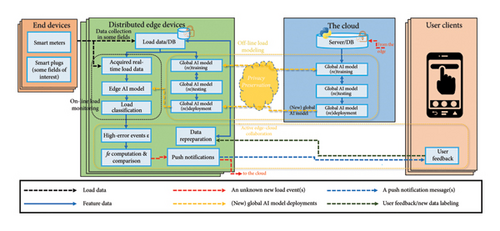
The proposed framework contains the following three parts: end devices, edge devices, and a cloud server.
The IoT end devices, which form a minimal set of current and voltage sensors in each practical field of interest, acquire private IoT data (i.e., private aggregated (circuit-level) load data) in the end device tier. These data can be retrieved as smart meter data from smart meters. In some fields of the practical fields of interest, (appliance-level) smart plugs, which can serve as switching gadgets, are installed and used to label relevant electrical appliances with their load combination circumstances as load classes (this is a one-time, short-term intrusive setup period for long-term energy disaggregation to be achieved; it is needed for the prior determination of load classes derived from load combination circumstances to be labeled and identified through multiclass/multilabel load classification. Alternatively, this setup period could be realized through a preliminary stage of energy disaggregation [20]). All fields of the practical fields of interest are leveraged in the framework for offline collaborative load modeling. In the edge device tier, the acquired private load data are transmitted to on-site autonomous edge devices. The on-site autonomous edge devices connected with the end devices and geographically distributed with storage and computing capabilities are in charge of the load data (pre)processing and analysis tasks for online autonomous load monitoring to be achieved finally. This scheme is based on a deployed edge AI model derived from a global cloud AI model for the final achievement of online autonomous load monitoring/energy disaggregation. In the scheme, the on-site devices collaborate with the cloud in the cloud tier so that unknown new/latent electrical appliances can be learned/modeled for a new global cloud AI model where only model parameters (model weights and biases) are exchanged (as opposed to local raw private load data) between the cloud and edge sides during the model training process under active HFL.
The distributed on-site autonomous edge devices with private load data, which are acquired, analyzed for offline collaborative load modeling of energy disaggregation, and inferred to achieve online autonomous load monitoring with active edge–cloud collaboration in the smart energy disaggregation framework, can be server-class machines or systems such as Advanced RISC Machine (ARM)® processor–based embedded systems located on-site in multiple fields of interest. Such systems are deployed with their local but global AI model in active HFL for smart energy management applications like an active privacy-preserving distributed residential mains energy disaggregation application implemented through edge–cloud collaboration in the framework of this research. When a distributed on-site autonomous edge device(s) in the edge device tier detects an unknown new/latent appliance(s) with a low confidence level of fe for certain times, it collaboratively trains a new global AI model under HFL with the cloud, cooperating with all the other on-site edge devices (the new energy disaggregation model to be deployed as edge AI for smart energy disaggregation at the edge is collaboratively/globally trained over distributed local private load data that reside at the edge side).
In the cloud tier, the cloud assists the distributed on-site autonomous edge devices in coestablishing a (new) global AI model under data privacy preservation and refreshes the well-trained model to be coestablished finally for a new appliance class(es), that is, an unknown new/latent electrical appliance(s), to achieve online autonomous load monitoring for smart energy disaggregation at the edge. Such an edge–cloud collaboration mechanism that advances the whole system for smart energy management applications is required because the performance of a trained AI model executed on distributed on-site autonomous edge devices for an energy management application is decreased by unknown new/latent appliances. The whole system is developed under data security and privacy preservation. In the edge–cloud collaboration mechanism developed in this research, global knowledge modeling for global knowledge sharing of new consolidated AI is triggered under a certain criterion in which an unknown new appliance frequently appears for use at certain times in a field. In the cloud with the edge–cloud collaboration mechanism developed in this research, an unknown new/latent appliance(s), which is detected at the edge and related to a resulting fe confidence level, is labeled through user feedback via which a query requesting the appliance type/name class label(s) is sent over the Internet to the homeowner(s), where a practical application paradigm involving the LINE-Notify push notification service [38] is implemented. As the edge–cloud collaboration mechanism is realized, the distributed on-site autonomous edge devices that collaborate with the cloud in HFL can achieve smart energy disaggregation at the edge. The systematic application paradigm, Active FedNILM, of the proposed framework in Figure 1 for smart active distributed edge–cloud collaborative computing–based energy disaggregation across multiple load monitoring fields of interest under data privacy preservation is provided in Figure 2. The pipeline of Active FedNILM is presented in Section 2.2; the active learning-integrated edge–cloud collaborative FL development is described in detail in Sections 2.3 and 2.4.
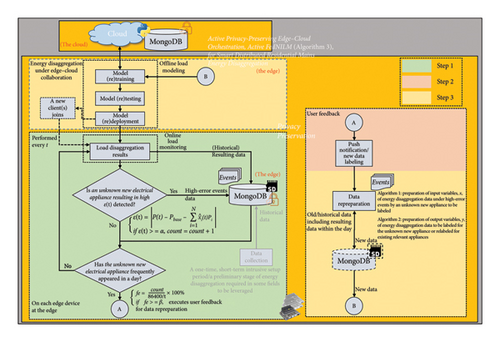
2.2. Pipeline of Actively (Autonomously) Distributed Mains Energy Disaggregation Under Edge–Cloud Collaboration Considering Data Privacy Preservation
Figure 2 shows the pipeline of the active privacy-preserving and distributed edge–cloud collaborative computing–based mains energy disaggregation methodology in the proposed energy management framework for implementing smart energy disaggregation at the edge.
In the pipeline, distributed on-site end devices are used to acquire load data for online load monitoring/energy disaggregation. The acquired load data are then transmitted to the distributed on-site autonomous edge devices, which communicate with their communicated end device(s) in their field. The distributed on-site autonomous edge devices (Step 1) that receive acquired load data from their end device(s) are responsible for performing smart energy disaggregation, where (1) offline collaborative load modeling (Steps 2 and 3 (Algorithms 1–3)), which may contain an unknown new/latent appliance(s), is performed first via a (new) global cloud AI model to be collaboratively trained (coestablished) between the cloud side and the edge side for the development of (new) global consolidated AI as (new) edge AI under HFL preserving data privacy; (2) online autonomous load monitoring (Step 1) is then executed at the edge through the well-trained (new) global cloud AI model that is deployed remotely as (new) edge AI; and 3) active edge–cloud collaboration (Steps 2 and 3 (Algorithms 1–3)), which advances the whole energy disaggregation implementation as the application paradigm of the proposed energy management framework, is finally achieved across multiple fields of interest in the proposed framework for modeling and identifying an unknown new/latent appliance(s). With the active edge–cloud collaboration tactic (Steps 1–3), the cloud cooperating with the edge can assist the autonomously distributed on-site edge devices to refresh their local AI model knowledge in identifying unknown new/latent appliances seamlessly for achieving smart mains energy disaggregation at the edge.
-
Algorithm 1: Preparation of the feature variables of the energy disaggregation data to be labeled.
-
Definitions:t: time slot t in seconds; Events: a list that stores the time (timestamps) at which high-error events are caused by an unknown new appliance and detected in a day, that is, Events = {t1, t5, …, ti, …, tn}, where n is the total number of detected high-error events; : a list for storing historical feature data to be queried from the local DB (the edge), that is, , where m is the total number of historical feature data queried in the consideration of a prespecified power tolerance τ according to Events; Dataprepared: a list for storing all queried historical data (i = 0,1, …, n − 1) to be prepared for Algorithm 2, that is, ; P(t) and Q(t): the acquired historical total real power and reactive power measured at t in a field, respectively; Punknown: real power consumption of an unknown new appliance obtained and labeled through user feedback; MongoDB_DMIR: a DB table that stores daily model inference records via online energy disaggregation; P(t)′: total real power consumption to be prepared for Algorithm 2, where queried P(t)–obtained Punknown; MongoDB_Historical: a DB table that stores historical data during the one-time, short-term intrusive setup period (or the preliminary stage of energy disaggregation).
-
Input:Event s
-
Output: Dataprepared
-
While online energy disaggregation is performed every t do:
-
If the data repreparation process is triggered then:
-
Punknown⟵ the real power consumption of the unknown new electrical appliance obtained and labeled through user feedback
-
fori from 0 to (len(Events) – 1) do
-
P(t)⟵ MongoDB_DMIR.find({“Time”: Events[i]}, {“P(t)”: 1})
-
//retrieved historical total real power consumption, with Punknown, in association with detected high-error events
-
P(t)′⟵P(t) − Punknown
-
//the retrieved power consumption to be subtracted by Punknown
-
MongoDB_Historical.find({”$and”: [{“P(t)”: {”$gte”: P(t)′ − τ}}, {“P(t)”: {“$lt”: P(t)′ + τ}}, {“Sensor Type”: “Smart Meter”}]}, {“P(t)”: 1, “Q(t)”: 1})
-
//historical feature data retrieved in the consideration of a prespecified power tolerance and in association with the detected high-error events
-
Dataprepared.append ()
-
//prepared feature data to be labeled as an unknown new appliance causes high-error events in the field
-
End for
-
End If
-
End While
- ※
MongoDB.find({query},{projection}) performs a MongoDB query operation with projection. Here, “query” is a query filter (notes: $and means performing the logical AND operation, $gte implies selecting a field value that is greater than or equal to a specified value, and $lt means selecting a field value that is less than a specified value).
- ※
Sensor types include “smart meter” and “power meter.”
-
Algorithm 2: Preparation of the label variables of the energy disaggregation data to be labeled for an unknown new appliance or relabeled for existing relevant appliances.
-
Definitions: l: a list for storing classification results obtained for C classes, that is, , where C is the total number of existing relevant appliance classes and ci is a binary bit representing 1 for an appliance in load class i that is on or 0 for that appliance that is off; L: a list for storing inference results obtained, by an old (the present) global AI model, of Dataprepared obtained in Algorithm 1, that is, , where the total number of feature data to be inferenced for is m; Model.predict( ): model inference performed by an old (original) AI model; L′: a list for storing all possible label lists, that is, , where γ is the total number of possible label lists (γ ≤ m); L″: a list for storing classification results obtained for feature data acquired and stored at t − 1 (a high-error event has been detected and stored at t), that is, L″=[l]1×1; Correctness: a list for storing label correctness coefficients of label lists, that is, , where ρ is a label correctness coefficient such as ; LNewLabel: a label list that is assigned by a label list, from L′, which has the highest label correctness coefficient, where LNewLabel=[l]1×1; OldData: an old (original) dataset that stores historical energy disaggregation data; NewData: a newly prepared energy disaggregation dataset to be balanced through the synthetic minority oversampling technique (SMOTE) and used to collaboratively train a new global AI model via HFL for the new unknown appliance.
-
Inputs:Dataprepared
-
Outputs: NewData
-
While online energy disaggregation is performed every tdo:
-
IfDataprepared has been obtained in Algorithm 1then:
-
fori from 0 to (len(Dataprepared) − 1) do
-
L ← Model.predict(Dataprepared[i])
-
//inference results produced by the present global AI model applied to obtained in Algorithm 1
-
L′← list (set(L))
-
//all possible label lists
-
L″ ← Model.predict (MongoDB_DMIR.find({“Time”: {Events[i]+ date.timedelta(seconds = −t)}}, {“P(t)”: 1,“Q(t)”: 1})
-
//classification results obtained for feature data at t − 1
-
for j from 0 to (len(L′) − 1) do
-
Correctness.append(label_correctness_check (L′[j], L″))
-
//for instance,
-
End for
-
LNewLabel ← L′[Correctness.index(max (Correctness))]
-
//returning the label list, from L′, whose label correctness coefficient has the maximum value
-
LNewLabel ← LNewLabel.append([1])
-
//the label list is appended by a class label “1” for the unknown new appliance resulting in the high-error event, where the total number of appliance classes is C + 1
-
NewData.append([MongoDB_DMIR.find({“Time”: Events[i]}, {“P(t)”: 1}), MongoDB_DMIR.find({“Time”: Events[i]}, {“Q(t)”: 1}), LNewLabel])
-
//preparing a new energy disaggregation dataset where feature data polluted due to high-error events caused by the unknown new appliance are correctly labeled as class “1” with a new class
-
End for
-
OldData← MongoDB_Historical.Find({“Sensor Type”: “Smart Meter”}, {“P(t)”: 1, “Q(t)”: 1, “GroundTruth”: 1})
-
fori from 0 to (len(OldData) − 1) do
-
OldData[i] ← [(OldData [i])[0], (OldData [i])[1], ((OldData[i])[2]).append([0])]
-
//obtaining historical feature data to be relabeled for the existing relevant appliances where they were not operated for use with the unknown new appliance to be labeled as class “0” for the new class
-
End for
-
NewData←NewData+OldData
-
NewData← SMOTE(NewData)
-
//utilizing the SMOTE to balance the prepared energy disaggregation data to be used to collaboratively train a new global AI model via HFL where the cloud ultimately deploys the well-trained model remotely on each edge device at the edge
-
End If
-
End While
-
Algorithm 3: Active privacy-preserving edge–cloud collaboration algorithm, Active FedNILM, for implementing smart mains energy disaggregation at the edge.
-
Server Execution:
-
If the cloud is requested by one edge client(s), detecting an unknown new/latent electrical appliance(s) using (3) and (4) and repreparing its local private load data based on Algorithms 1 and 2, from the edge side for a new global consolidated AI model for performing smart energy disaggregation at the edge then:
-
Initialize the trainable model parameters w0, including the weight coefficients and biases, of a global AI model in the cloud, where wt=0⟵Wx related to the adjustments of (5) and (6) in collaborative training.
-
S⟵ a set of K clients in the edge–cloud collaborative computing framework
-
Send the initial global model to the K clients.
-
for each communication round t = 0, 1, 2, … do
-
parfor each client k ∈ Sdo//for-loop iterations in parallel
-
-
End parfor
-
from (8) to be optimized under HFL based on FedAVG
-
End for
-
Broadcast the final well-trained model to all the K clients.
-
End If
-
Client Execution:
-
procedureClientUpdate(k, w)
-
B⟵ split local private data Pk into batches of size bs
-
for each local epoch e < Edo//for multiple epochs
-
for batch b ∈ Bdo
-
w⟵w − η∇l(w) according to (7)//finding w∗ that minimizes the overall loss induced over the distributed local private data Pk where k ∈ {1, 2, … , K} (note: the edge device(s) triggering the edge–cloud collaboration mechanism uses its reprepared local private load data to collaboratively train the model (refer to Algorithms 1 and 2 for the entire data repreparation process))
-
End for
-
End for
-
returnw//to the server
In the pipeline, the cloud is utilized for offline collaborative load data modeling via an AI model that achieves global knowledge modeling and enables global knowledge sharing, which collaboratively trains, with the autonomously distributed on-site edge devices, the AI model (the cloud only is not suitable for applications in which they are implemented under, for instance, sensitive circumstances facing network latency and congestion). The distributed on-site autonomous edge devices perform online autonomous load monitoring based on the AI model that is deployed from the cloud side to the edge side after collaboratively training the model in HFL is completed. Moreover, they can collaborate with the cloud based on an edge–cloud collaboration mechanism under HFL to address data security and privacy concerns when an unknown new/latent electrical appliance(s) that cannot be identified at the edge exists. The edge–cloud collaboration mechanism in the pipeline of the proposed framework is described in Section 2.3, where a data repreparation process for preparing new private energy disaggregation data (local private load data consisting of feature data and corresponding label data), which are prepared and used to collaboratively train a new global consolidated AI model through HFL, is also described. In Section 2.4, the AI model (a multilabel load identifier implemented by a DL-accommodated feedforward ANN in the proposed framework) to be (re)trained in HFL and (re)deployed remotely at the edge is presented. Through the edge–cloud collaboration mechanism, distributed on-site autonomous edge devices in the proposed framework, which form a novel complement of the cloud, can collaborate with the cloud to realize smart (residential) energy disaggregation addressing data privacy and security concerns. The edge–cloud collaboration mechanism advances the entire application paradigm.
2.3. Active Edge–Cloud Collaboration Relating to Confidence Level fe of Unknown New/Latent Electrical Appliances Considering Similar Real and Reactive Power for Smart Residential Distributed Mains Energy Disaggregation at the Edge
Training a powerful global AI model in a centralized manner or on an edge device(s) to identify all electrical appliances for the energy disaggregation purpose is impractical. Alternatively, the model can be advanced through edge–cloud orchestration to adaptively update it to a (new) global consolidated AI model based on actual environments where the distributed on-site autonomous edge devices are located. Therefore, an edge–cloud collaboration mechanism is developed in the proposed framework to achieve such an alternative for performing active privacy-preserving distributed (smart) residential mains energy disaggregation at the edge. The mechanism is described as follows.
As shown in Figure 2 showing the pipeline of active privacy-preserving distributed energy disaggregation under edge–cloud collaboration in the proposed framework, the proposed edge–cloud collaboration mechanism for enabling the cloud side to cooperate with the edge side is primarily composed of (1) online autonomous load monitoring/energy disaggregation related to a confidence level of fe for an unknown new/latent electrical appliance(s) where data tuples, including acquired mains data, energy disaggregation results produced by deployed (new) global AI as (new) edge AI, and high-error events that result from the unknown new/latent electrical appliance(s), are stored locally (which are private data used for further collaborative (new) global AI modeling based on HFL) (Step 1); (2) user feedback implemented to label the unknown new/latent electrical appliance(s) for the next data repreparation process (Step 2) for the following offline collaborative load modeling based on HFL considering data security and privacy; and (3) data repreparation for preparing new local private energy disaggregation data to be learned/modeled for a (new) global consolidated AI model trained collaboratively between the cloud side and the edge side and be, finally, remotely deployed on the distributed on-site autonomous edge devices at the edge (Step 3). The edge–cloud collaboration mechanism developed in this research can help distributed on-site autonomous edge devices adapt to their load monitoring environment. When an unknown new/latent appliance(s) frequently appears for use in a day, the reprepared energy disaggregation data, through Step 2, reflecting the unknown new/latent appliance(s) are used for offline collaborative load modeling upon which a new global AI model is cotrained via HFL across all appliance classes. Once a (new) global consolidated AI model has been cotrained with a satisfactory classification performance level through HFL across all appliance classes (global knowledge modeling), it is remotely deployed for the task of online autonomous load monitoring at the edge (global knowledge sharing) to achieve smart energy disaggregation under data privacy and security preservation across multiple fields of interest at the edge.
In (4), count represents the total number of high-error events that are detected and denoted during online load monitoring/energy disaggregation of (3) resulting in a high power error level at time slot t, and it is counted in 86400/t time slots each day.
In the privacy-preserving edge–cloud collaboration mechanism developed in the proposed framework for active distributed energy disaggregation, when an unknown new/latent electrical appliance that has been frequently appeared/used in a day is detected in Step 2, the edge device executes a user feedback process, via a push notification service such as LINE-Notify, for the data repreparation purpose. According to (2), power consumption of the detected unknown new/latent electrical appliance to be identified, Punknown, can be deduced as ε(t) = P(t), where (1) = 0 (where i = 1, 2, …, N) for the existing relevant appliances (which can be informed by the on-site autonomous edge device as the home gateway and be acted upon by the user turning them off) and (2) ideally, Pbase(t) = 0, which can be statistically estimated during the one-time, short-term intrusive setup period or the preliminary stage of energy disaggregation in practice as shown in [20]. Once the user feedback process is completed, a data repreparation process starts with addressing the detected high-error events with the obtained Punknown; the data repreparation process involves two algorithms in the subsequent step, Step 3, for preparing new local private energy disaggregation data to be used to collaboratively train in HFL a new global AI model across all appliance classes.
In Step 3 of the privacy-preserving edge–cloud collaboration mechanism developed in the proposed framework for smart energy disaggregation, the data repreparation process involves Algorithms 1 and 2, respectively. Algorithm 1 is used to prepare the input variables x (feature data) of the energy disaggregation data under high-error events produced by a detected unknown new/latent appliance to be labeled. Algorithm 2 is used to prepare the output variables y (label data) of the energy disaggregation data to be labeled for the unknown new/latent appliance or relabeled for the existing relevant appliances. Through Algorithms 1 and 2, feature data polluted by high-error events caused by an unknown new/latent appliance can be correctly labeled as class “1” with a new appliance class. Moreover, historical feature data can be relabeled for the existing relevant appliances with which they were not operated for use with the use of the unknown new/latent appliance to be labeled as class “0” for them for the new appliance class. Finally, all local private load data are balanced and used to collaboratively train a new global AI model via HFL. The model learns over distributed local private load data across all appliance classes under data security and privacy preservation and serves as new edge AI for implementing online mains energy disaggregation at the edge.
An illustrative numerical example showing how Algorithms 1 and 2 work to reprepare appliance data of an unknown new/latent appliance detected is provided as follows.
Suppose that, there are five monitored major electrical appliances considered in this illustrative example and shown in Table 2. Also, a simulated 1-day power profile of a load monitoring field of interest that is monitored nonintrusively (the HEMS with smart energy disaggregation at the edge identifies the five already-modeled major electrical appliances every 300 s; 1 day has 288 time slots) is shown in Figure 3, where a new/latent appliance, which produces high-error events (high ε(t)), to be detected and learned for smart energy disaggregation at the edge appears (frequently) for appliance usage in the field.
| xi electrical features | Refrigerator i = 0 | Electric pot i = 1 | Induction cooker i = 2 | Hair dryer i = 3 | Fan i = 4 | New/latent appliance (electronic load) i = 5 | |
|---|---|---|---|---|---|---|---|
| Mode 1 | Mode 2 | ||||||
| Real power (Pi) (W) | 130 | 650 | 870 | 1060 | 540 | 50 | 340 |
| Reactive power (VAR) | 130 | 0 | 0 | 0 | 260 | 0 | 0 |
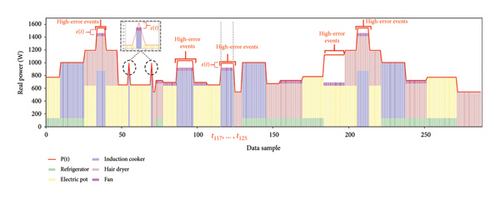
First, at t117 as the illustrative time instance, P(t) = 990, , , and ε(t) = 70 according to (3) (ideally, Pbase = τi = 0). Suppose that, α = 50, β = 0.15 (i.e., 15%), and initial count = 0. As ε(t117) > α, count = count + 1. In this illustrative example (refer to Figure 3), totally, 59 high-error events, Events = {t36, …, t41, t56, t71, t88, …, t98, t117, …, t125, t184, …, t198, t207, …, t214}, are detected. According to (4), fe = (59/(86400/300)) × 100% ≅ 20%. As the computed fe is greater than or equal to 15%, a new/latent appliance appearing frequently in the field is detected, which has to be modeled, with the existing monitored appliances in the field, by a new AI model (the old AI model to be upgraded/rebuilt with a new prepared energy disaggregation/NILM dataset).
Then, once the new/latent appliance has been detected, turn off all the existing monitored appliances (i.e., set ) and then turn on the new/added appliance, to be labeled through user feedback in active learning, where ideally its power consumption, Punknown, can be measured and obtained approximately as the total power consumption: which is approximately the ground truth, rated power, of the detected new/latent appliance (in practice, this value is unknown, but can be estimated approximately as the total power measurement where all the existing monitored appliances are turned off).
Finally, according to Algorithm 1, P(t117) = 990 (W) via DB access, (W) where τ = 10, and Dataprepared = [[P(t), Q(t)]] = [[650, 0], [650, 260]] where Q(t) = 0 and Q(t) = 260 are obtained through a DB query with . Also, according to Algorithm 2 with the obtained Dataprepared in Algorithm 1, obtain L′ = [[Model.predict([650, 0])], [Model.predict([650, 260])]] = [l1, l2] = [[0, 1, 0, 0, 0], [1, 0, 0, 1, 0]] and obtain L″ = [[Model.predict([P(t116), Q(t116)])]] = [[Model.predict([660, 0])]] = [l] = [0, 1, 0, 0, 0]. Consequently, LNewLabel = L′[0] = [0, 1, 0, 0, 0], LNewLabel = LNewLabel.append(1) = [0, 1, 0, 0, 0, 1], and NewData = [[P(t117), Q(t117), LNewLabel]] = [[990, 0, [0, 1, 0, 0, 0, 1]]] (at t = 117) (the new/latent appliance will be modeled).
Corresponding to Figure 3, Figure 4 shows the (total) power profile by the six major appliances containing the new/latent appliance, which can be nonintrusively monitored correctly by a new AI model that has been well-trained on balanced NewData (= NewData + OldData) for smart energy disaggregation at the edge.
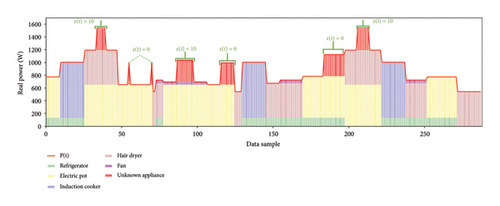
2.4. Residential Mains Energy Disaggregation as Multilabel Load Classification by a DL-Accommodated Feedforward ANN Collaboratively Trained in HFL
In (5) and (6), η is the prespecified learning rate; wiq denotes the weight coefficient between the ith output neuron in the output layer of the network and the qth hidden neuron in the hidden layer of the network; vqj represents the weight coefficient between the qth hidden neuron in the hidden layer of the network and the jth input neuron in the input layer of the network; a, whose derivative is a′, signifies the type of the activation functions prespecified for all the hidden neurons (q = 1, 2, …, l) in the hidden layer of the network; and wiq and vqj are adjusted in a supervised manner w.r.t. , where the present xj whose corresponding output is yi is inputted and is outputted/predicted by the network.
In Equation (7), l(⋅) is the overall (global) loss function. Also, n = ∑k∈Snk; S = {1, 2, …, k, …, K} for all K client devices; nk = |Pk| being the size of distributed local private data Pk of the kth client device; and n is the total size of all distributed local private data on the K client devices. Finally, lx(⋅) is the computed loss for a present input x which belongs to Pk.
3. Simulation Results
In this section, the proposed energy management framework, that is, an active privacy-preserving and distributed edge–cloud collaborative computing–based energy management framework, for implementing smart residential mains energy disaggregation at the edge is demonstrated and evaluated through simulations conducted in a laboratory environment.
Figure 5 illustrates the preliminary implementation of the framework. Figures 5(a) and 5(b) show the entire system and its architectural sketch in Active FedNILM complying with the methodology pipeline (Figure 2) with Algorithms 1, 2, and 3, respectively. Figure 5(c) shows the experimental setup. In the implementation, the distributed on-site autonomous edge devices (edge AI gateways A, B, and C (a new client)), which are connected with their end device(s) and networked with the cloud via the Internet, are configured and used as the core entity of the HEMSs to be monitored and managed at the edge. They are based on Advantech’s (Advantech Co., Ltd. in Taiwan (https://www.advantech.com/zh-tw)) Intel Atom® E3845/Celeron® J1900 Quad-Core processor–based edge AI gateways. In some fields, their end devices are their connected smart meter (which is used to acquire the total power (P(t) in (2)) of the field) and wirelessly communicated individual appliance-level power meters (which are used for the one-time, short-term intrusive setup period (offline collaborative load modeling) of long-term energy disaggregation (online autonomous load monitoring) in some fields). In some fields, the end device is just the smart meter. In the implementation, the cloud is based on Advantech’s WISE-PaaS Industrial IoT Platform. This architectural implementation of edge–cloud computing for the proposed framework with Active FedNILM to be showcased is a vanilla edge–cloud computing paradigm. The distributed on-site autonomous edge devices perform online autonomous load monitoring/energy disaggregation utilizing a deployed global AI model; they collaboratively train, with the cloud, a new global AI model using their local private load data with/without high-error event-related load data. If an unknown new/latent appliance(s) is detected (based on the developed active privacy-preserving edge–cloud collaboration mechanism), they can request the cloud for collaborative global AI remodeling under data security and privacy preservation. Thus, the entire framework can be improved in terms of its data confidentiality and system practicality, and the bandwidth of the backbone network can be saved. In the framework, with distributed on-site autonomous edge devices implementing the presented active privacy-preserving edge–cloud collaboration algorithm, the cloud collaboratively trains a global AI model that can achieve (1) global knowledge modeling over distributed local private load data residing at the edge and (2) global knowledge sharing across all local private load data sources under data security and privacy preservation, where the distributed on-site autonomous edge devices refresh their knowledge (the final consolidated AI model) for performing online autonomous load monitoring of smart energy disaggregation at the edge. In this study, smart residential mains energy disaggregation through the presented Active FedNILM algorithm is showcased as an illustrative application paradigm of the proposed framework. In the proposed framework, Active FedNILM, a proof-of-concept algorithm demonstration of active energy disaggregation based on an edge–cloud collaboration mechanism with FedAVG, is implemented in MATLAB® executed from within Python®. MATLAB® and Python® are installed and used on an Acer Predator G3-710 Intel® CoreTM i7-6700 CPU (3.40 GHz) (RAM: 16 GB) personal computer that serves as another entity of the cloud. In the MATLAB® software, Deep Learning Toolbox and Parallel Computing Toolbox are used; (1) a process-based, local, and central parallel pool with distributed parallel workers as the distributed on-site edge devices is used (the non-IID load data dumped from the cloud are distributed on the workers of the parallel pool and the codes implementing the presented algorithm are executed in parallel) and (2) a user-defined federatedAveraging function that takes the trainable model parameters of the model on each worker and returns the averaged trainable model parameters, to update the global model to be deployed as the models on the workers, across all the models is defined and used. As expected, the presented algorithm to be commercialized can be implemented in either the WISE-PaaS/AIFS (AI Framework Service) solution, which will leverage FL models, or FedML (https://fedml.ai), which is an open research library and benchmark to commercialize FL easily, scalably, and economically.
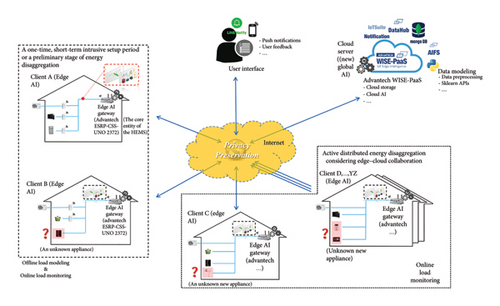
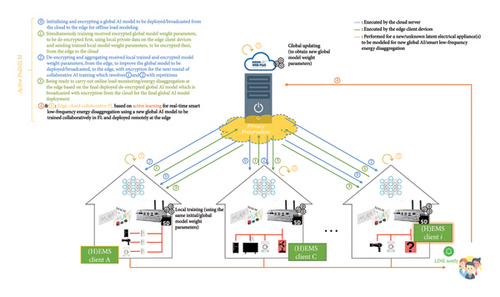
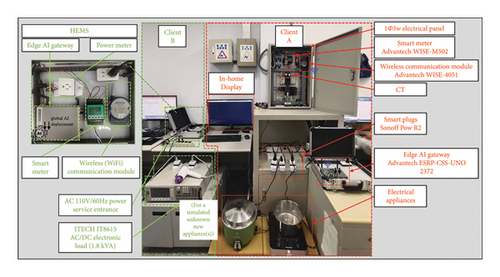
The proposed framework with the presented algorithm for smart energy disaggregation at the edge is an algorithmic and systemic innovation in the vanilla edge–cloud computing paradigm; two simulation scenarios below are executed and used to demonstrate the feasibility and effectiveness of the proposed framework with the presented algorithm. Table 3 lists the two simulation scenarios.
| HEMS framework | Client | ILM (e.g., a preliminary stage of energy disaggregation) | Energy disaggregation | Active edge–cloud collaboration | Privacy preservation | Global knowledge sharing | Electrical appliances | |||||||
|---|---|---|---|---|---|---|---|---|---|---|---|---|---|---|
| Refrigerator | Electric pot | Induction cooker | Hair dryer | Fan | Electronic load (a new appliance) | |||||||||
| Scenario 1 | Demo 1.1 | Single field | A | ✓ | ✓ | ✗ | ✗ | - | ✓ | ✓ | ✓ | ✓ | ✓ | ✗ |
| Demo 1.2 | ✗ | ✓ | ✓ | ✗ | ✓ | ✓ | ✓ | ✓ | ✓ | ✓ | ||||
| Scenario 2 | Demo 2 | Distributed multiple fields | A | ✓ | ✓ | ✓ | ✓ | ● | ✓ | ✓ | ✓ | ✗ | ✗ | ✗ |
| ● | ● | ✓ | ||||||||||||
| B | ✓ | ✓ | ✓ | ✓ | ● | ✗ | ✗ | ✗ | ✓ | ✓ | ✗ | |||
| ● | ● | ● | ● | |||||||||||
| C (new) | ✗ | ✓ | ✓ | ✓ | ● | ✗ | ✗ | ✗ | ✗ | ✗ | ✗ | |||
| ● | ● | ● | ● | ● | ● | |||||||||
In Scenario 1, an HEMS with basic energy disaggregation in a single field of interest is demonstrated. Demo 1.1 demonstrates traditional energy disaggregation, in which Client A implements traditional energy disaggregation, and its monitored major electrical appliances to be profiled prior for offline collaborative load modeling are nonintrusively monitored for online autonomous load monitoring. In addition, demo 1.2 demonstrates active energy disaggregation executed through edge–cloud collaboration, in which Client A implements energy disaggregation based on active learning (active energy disaggregation) conducted with edge–cloud collaboration in this research, where there is no need to profile a new major electrical appliance(s) prior for offline load modeling when the appliance(s) to be nonintrusively monitored through online autonomous load monitoring has appeared for frequent use in the field. In Scenario 2, a distributed HEMS framework with active energy disaggregation implemented over privacy-preserving distributed edge–cloud collaboration across all appliance classes in multiple fields of interest is demonstrated. Demo 2 demonstrates the active distributed energy disaggregation process executed via the privacy-preserving edge–cloud collaboration scheme to establish a (new) global AI/energy disaggregation model for its deployment in multiple fields of interest at the edge. In Demo 2, Clients A and B collaborate with the cloud to achieve smart energy disaggregation based on the presented active privacy-preserving distributed edge–cloud collaboration algorithm to build a (new) global consolidated AI model (as global knowledge modeling) that is able to identify all major electrical appliances including an unknown new/latent appliance; this model is remotely deployed as edge AI (for global knowledge sharing). Subsequently, Client C, a new client joining the framework, becomes capable of seamlessly identifying all the same major electrical appliances (as trainingless/fully nonintrusive energy disaggregation) by utilizing the deployed (new) global consolidated AI model collaboratively trained over local private load data of distributed Clients A and B.
3.1. Scenario 1
Table 4 lists the major electrical appliances that are nonintrusively monitored for this demonstration (Demo 1.1) in Scenario 1. The major electrical appliances include a refrigerator, electric pot (steamer), induction cooker, hair dryer, and fan. In this demonstration, a total of 2196 data instances for 29 load combination classes are collected, which are a class-imbalanced dataset. Figure 6 shows the collected class-imbalanced dataset (Figure 6(a)) to be balanced through the SMOTE technique upsampling the minority classes to avoid model overfitting, and the balanced dataset (Figure 6(b)) is used to train an AI/MLP model.
| Major electrical appliances | ||||||
|---|---|---|---|---|---|---|
| xi electrical features | Refrigerator i = 0 | Electric pot i = 1 | Induction cooker i = 2 | Hair dryer i = 3 | Fan i = 4 | |
| Mode 1 | Mode 2 | |||||
| Real power (W) (Pi) | 130 | 650 | 870 | 1060 | 540 | 50 |
| Reactive power (VAR) | 130 | 0 | 0 | 0 | −260 | 0 |
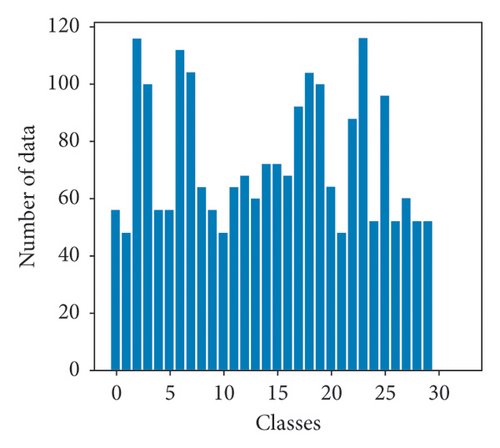
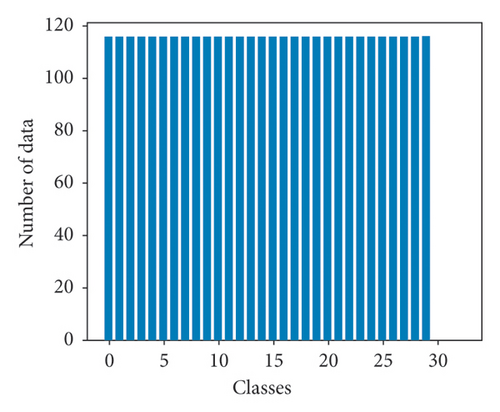
Figure 7 shows the feature data distribution of the balanced data instances (3480 data instances) to be standardized. In this demonstration, 85% of the whole dataset to be shuffled in advance is used as the training data for training an MLP model to conduct offline load modeling for online load monitoring, while the remaining 15% is used as the test data for testing the trained model to check its generalizability. Additionally, the classification performance metric is based on the F1 score.
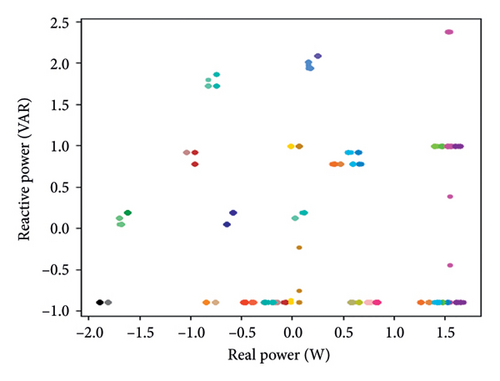
To train the MLP model for offline load modeling, three hidden layers are configured, and each of which is composed of 40 hidden neurons with a ReLU-style activation function. The weight optimizer specified for the iterative model training is “adam.” Figure 8 shows the training trajectory (the loss curve) obtained by the model that has undergone the training process, and the achieved loss value is 0.023. Table 5 lists the classification performance evaluation results obtained by the trained model. As shown in Table 5, the trained model achieves an excellent level of weighted average precision, recall, and F1 score of 0.99, 0.99, and 0.99, respectively, across all the five appliance classes considering their operational on and off states. Overall, as indicated in Table 5, a weighted average F1 score of 0.99 is achieved.
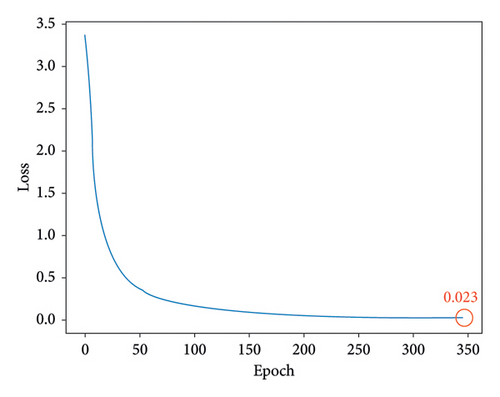
| Precision | Recall | F1 score | Support | |
|---|---|---|---|---|
| Refrigerator | 1.00 | 0.97 | 0.98 | 238 |
| Electric pot | 0.98 | 1.00 | 0.99 | 242 |
| Induction cooker | 1.00 | 1.00 | 1.00 | 250 |
| Hair dryer | 1.00 | 1.00 | 1.00 | 247 |
| Fan | 0.99 | 1.00 | 1.00 | 246 |
| Weighted avg. | 0.99 | 0.99 | 0.99 | 1223 |
- Note: The overall classification accuracy is 0.981.
In this demonstration, to verify the generalizability of the trained model for a new electrical appliance that has frequently appeared in the field, we use a programmable AC/DC electronic load (ITECH IT8615: 1.8kVA max) to simulate it with (P, Q) = (380 W, 0 VAR). Table 6 presents the classification performance evaluation results obtained by the trained model on the test data with the feature data obtained from the simulated, newly added electrical appliance. As indicated in Table 6, the trained model achieves a value of precision, recall, and F1 score of 0.85, 0.84, and 0.85, respectively, across all the five appliance classes. As listed in Table 6, the model has no ability to classify the unknown appliance simulated by the electronic load (the classification performance of a trained global AI model run on distributed on-site edge devices for online load monitoring/energy disaggregation may degrade over time with unknown new/latent electrical appliances), so it should be retrained (i.e., a new AI model for basic energy disaggregation is needed) through active learning via the developed edge–cloud collaboration mechanism for offline load modeling and redeployed for online autonomous load monitoring/energy disaggregation. We demonstrate this as follows.
| Precision | Recall | F1 score | Support | |
|---|---|---|---|---|
| Refrigerator | 1.00 | 0.88 | 0.94 | 132 |
| Electric pot | 0.67 | 1.00 | 0.80 | 98 |
| Induction cooker | 1.00 | 1.00 | 1.00 | 68 |
| Hair dryer | 0.44 | 1.00 | 0.62 | 16 |
| Fan | 1.00 | 0.83 | 0.91 | 96 |
| An unknown appliance (by electronic load) | — | — | — | 68 |
| Weighted avg. | 0.85 | 0.84 | 0.85 | 478 |
Table 7 presents the major electrical appliances that are nonintrusively monitored via active learning with the developed edge–cloud collaboration mechanism for this demonstration (Demo 1.2) in Scenario 1. In this demonstration, the HEMS with the energy disaggregation identifies the on/off status of all the electrical appliances every 300 s (t = 300; 1 day has 288 time slots); energy disaggregation is addressed as a multilabel classification task. In addition, α = 50 and β = 15%.
| Major electrical appliances including three new/latent appliances in 3 days each | |||||||||
|---|---|---|---|---|---|---|---|---|---|
| xi electrical features | Refrigerator i = 0 | Electric pot i = 1 | Induction cooker i = 2 | Hair dryer i = 3 | Fan i = 4 | New appliance a (electronic load) i = 5 in Day 1 | New appliance b (electronic load) i = 6 in Day 2 | New appliance c (electronic load) i = 7 in Day 3 | |
| Mode 1 | Mode 2 | ||||||||
| Real power (W) (Pi) | 130 | 650 | 870 | 1060 | 540 | 50 | 380 | 200 | 130 |
| Reactive power (VAR) | 130 | 0 | 0 | 0 | −260 | 0 | 0 | 0 | −70 |
As an illustrative example, Figure 9 shows the power profile produced by the field on Day 2, where high-error events produce ε(t) values that are greater than or equal to α (=50 W here). These events are caused by the involvement of new appliance “b.” Notably, the energy disaggregation results shown in Figure 9 are obtained by an AI model, that is, an MLP network, which has been well trained in the cloud for new appliance “a” that is newly added on Day 1 in the field. In this illustrative example, as a frequent error confidence level (fe) of 15.62% that is obtained is greater than or equal to β (= 15% here), the HEMS with the active energy disaggregation implemented over the developed edge–cloud collaboration mechanism works to train a new AI model (i.e., to reestablish and retrain the old AI model) for all the major appliances including the two new appliances each on each of the 2 days, in the cloud based on Algorithms 1 and 2 for the achievement of online autonomous load monitoring/energy disaggregation at the edge in the field. Note that, the specific appliance name/ID, unknown appliance “a” or “b,” is specified by the user through the user feedback process in Figure 2.
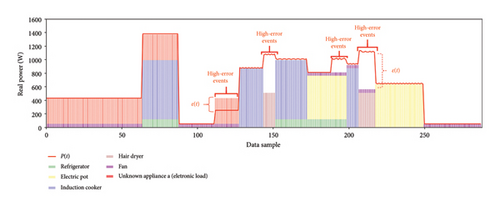
Figure 10 shows the detection and classification results obtained for the new appliances (new appliances “a,” “b,” and “c” on Days 1, 2, and 3, respectively) to be learned in the cloud (global AI) through active learning over the developed edge–cloud collaboration mechanism and nonintrusively monitored at the edge (local edge AI from the global AI model to be deployed). In Figure 10, the blue line indicates the situations in which unknown (unseen) new/latent appliances that produce high ε(t) values (indicated by the dashed gray line) have frequently appeared for use in the field, while the red line denotes the situations in which each of the appliances that have frequently appeared for use in the field is learned and classified successfully after the AI model update (active energy disaggregation over the developed edge–cloud collaboration mechanism) is completed. Table 8 presents the classification results obtained for the appliance classes to be classified and evaluated with the obtained F1 score obtained by the corresponding AI model (the AI model undergoes the three AI model updates shown in Figure 11). As presented in Table 8, the final AI model (new model “c”) achieves an excellent level of classification performance, with an F1 score of 0.98 across all the eight electrical appliances. Referring to Figure 9 as the illustrative power profile for the field on Day 2 and to Figure 10, Figure 11 shows the correct classification results obtained by the AI model (new model “b”), which is evaluated and summarized (for the two AI model updates for new appliances “a” and “b”) in Table 8.
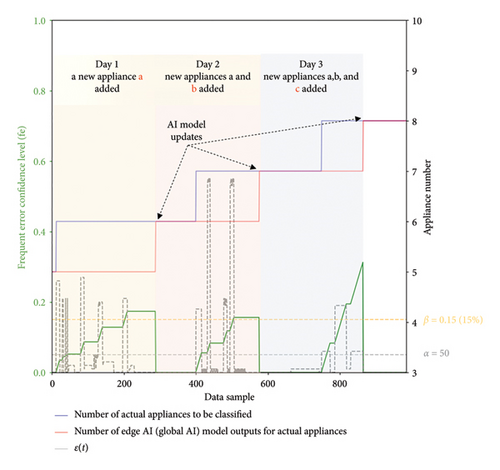
| Appliance class to be classified with obtainedF1score by the corresponding AI model | |||||||||
|---|---|---|---|---|---|---|---|---|---|
| Refrigerator | Electric pot | Induction cooker | Hair dryer | Fan | Unknown appliance a (electronic load) | Unknown appliance b (electronic load) | Unknown appliance c (electronic load) | ||
| AI model | Old model | 0.98 | 0.99 | 1.00 | 1.00 | 1.00 | ✗ | ✗ | ✗ |
| New model a | 0.98 | 0.98 | 1.00 | 1.00 | 1.00 | 1.00 | ✗ | ✗ | |
| New model b | 0.98 | 0.98 | 0.99 | 0.99 | 0.98 | 1.00 | 0.95 | ✗ | |
| New model c | 0.99 | 0.99 | 0.98 | 0.98 | 0.99 | 1.00 | 0.94 | 1.00 | |
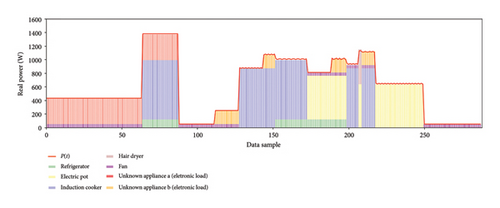
3.2. Scenario 2
According to Algorithm 3, in Scenario 2 (Demo 2), we demonstrate that smart energy disaggregation can be achieved by the developed active privacy-preserving distributed edge–cloud collaboration mechanism in the proposed energy management framework, and this is demonstrated as an illustrative application paradigm of the framework. Clients A and B are leveraged and converged through global consolidated AI knowledge modeling and sharing for the smart energy disaggregation purpose. Additionally, trainingless/seamless/fully nonintrusive online autonomous energy disaggregation in the field of Client C, which is newly contained in the framework, can be seamlessly achieved by the global consolidated AI model that has already been trained over local private load data of distributed Clients A and B without the data security and privacy concerns. This model is remotely deployed and directly utilized at the edge (i.e., deployed on and utilized by the edge gateway of Client C). Overall, the proposed framework improves HEMSs with and without energy disaggregation.
Table 9 presents the major electrical appliances that are nonintrusively monitored in Clients A, B, and C, where the clients can be leveraged in HFL during offline collaborative load modeling and improved with online autonomous load monitoring in the proposed energy management framework, that is, an active privacy-preserving distributed edge–cloud collaborative AI-based energy management framework for smart energy disaggregation. First, a global AI model (an MLP) with two hidden layers containing 18 and 5 hidden neurons specified for the first and second hidden layers, respectively, is configured and collaboratively trained between the cloud and edge sides through the presented HFL process. A sigmoid-style activation function is established and used for the hidden layers of the model. The training process is initialized at the cloud side and conducted to distributed local private periodically collected load data, which are balanced and standardized in advance, of geographically distributed Clients A and B at the edge side that collaborates with the cloud side in an iterative supervised learning manner. The model is trained well. Table 10 presents the energy disaggregation data modeling results obtained by the well-trained global consolidated AI model. The global AI model is remotely deployed on edge gateways A and B at the edge once the model has been well trained through the HFL process.
| xi electrical features | Client A | Client B | Client C | ||||
|---|---|---|---|---|---|---|---|
| Refrigerator i = 0 | Electric pot i = 1 | Induction cooker i = 2 | Hair dryer i = 3 | Fan i = 4 | — | ||
| Mode 1 | Mode 2 | ||||||
| Real power (Pi) (W) | 130 | 650 | 870 | 1060 | 540 | 50 | — |
| Reactive power (VAR) | 130 | 0 | 0 | 0 | −260 | 0 | — |
| Precision | Recall | F1-score | Support | |
|---|---|---|---|---|
| Refrigerator | 0.86 | 0.94 | 0.90 | 627 |
| Electric pot | 1.00 | 0.94 | 0.97 | 660 |
| Induction cooker | 0.94 | 1.00 | 0.97 | 655 |
| Hair dryer | 1.00 | 1.00 | 1.00 | 657 |
| Fan | 0.62 | 0.86 | 0.72 | 625 |
| Weighted avg. | 0.89 | 0.95 | 0.91 | 3224 |
Next, the active privacy-preserving distributed edge–cloud collaborative energy disaggregation ability of the proposed framework is demonstrated, where a new global consolidated energy disaggregation model (new cloud AI for smart energy disaggregation) intended to serve as edge AI deployed from the cloud side to the edge side can be trained by the presented Active FedNILM (Algorithm 3) and deployed for the implementation of smart online mains energy disaggregation at the edge to all the edge clients (trainingless/seamless/fully nonintrusive energy disaggregation) in the framework. In the framework, a new appliance, unknown appliance “a” simulated by the electronic load with (P, Q) = (130 W, −70 VAR) in a simulated power profile, is added for use in Client A. Table 11 indicates the energy disaggregation data modeling results obtained by the new global AI model that has been well trained via Active FedNILM. The model is trained for 50 rounds (communication rounds) with 150 epochs per round. The minibatch size is specified as 20. A value of 0.8 and 0.1 is set for the learning rate and momentum term, respectively. The resulting training progress of the model is displayed in Figure 12, where the elapsed time required for the collaborative training process is ∼3.75 min. As displayed in Figure 12, the collaboratively trained model converges for the addressed energy disaggregation problem as the communication rounds go by, where the overall classification rate is achieved at 92.12%. As indicated in Table 11, the trained new global consolidated AI model achieves an excellent level of precision, recall, and F1 score of 0.94, 0.93, and 0.93, respectively, across all the six appliance classes. The overall classification rate of the new global consolidated AI model is improved by ∼11%, from 80.62% to 91.86%, after the collaborative model training process is completed. Table 12 summarizes the obtained improvements of the overall classification rate of the new global consolidated AI model for Clients A and B leveraged through the presented Active FedNILM. As summarized in Table 12, the classification rate improvements obtained for Clients A and B achieving smart energy disaggregation, under data privacy preservation, at the edge are ∼11% and ∼3%, respectively. The new global AI model can be used to achieve online seamless (fully nonintrusive/trainingless) load monitoring for new clients in the proposed smart energy disaggregation framework. The new global consolidated AI model, which is capable of identifying the six major electrical appliances, is remotely deployed on edge gateways A, B, and C at the edge once the new model has been well trained via the presented Active FedNILM.
| Precision | Recall | F1-score | Support | |
|---|---|---|---|---|
| Refrigerator | 1.00 | 0.85 | 0.92 | 752 |
| Electric pot | 1.00 | 0.93 | 0.97 | 700 |
| Induction cooker | 0.94 | 1.00 | 0.97 | 689 |
| Hair dryer | 0.99 | 1.00 | 1.00 | 697 |
| Fan | 0.74 | 0.84 | 0.79 | 664 |
| Unknown appliance a (electronic load) | 0.97 | 1.00 | 0.98 | 152 |
| Weighted avg. | 0.94 | 0.93 | 0.93 | 3654 |
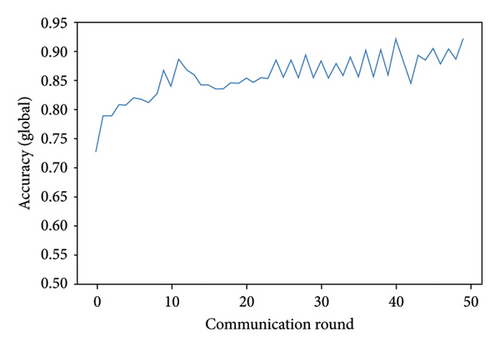
| Accuracy (%) | Improvement (%) | ||
|---|---|---|---|
| Without active FedNILM | With active FedNILM | ||
| Client A | 80.62 | 91.86 | Approximately + 11.0 |
| Client B | 88.85 | 91.67 | Approximately + 2.8 |
Figure 13 illustrates the simulated power profile to be nonintrusively monitored by the new global AI model in Client A, where the old global AI model, which cannot identify the new/latent electrical appliance producing the high-error events, is upgraded as the new global AI model in the framework. Figure 14 shows that Clients A and B are leveraged in the presented Active FedNILM scheme where the old global AI model is upgraded as the new global AI model for the future identification of the new appliance. Moreover, this figure indicates that edge Gateway B utilizes the same newly deployed global AI model at the edge, having the same ability of classifying the six major appliances for online autonomous energy disaggregation in the field of Client B. Figure 15 shows that Client C, which joins the framework on Day 3 and requests the cloud to deploy the newest global consolidated AI model on its edge gateway, utilizes the same new deployed global AI model having the same ability of classifying the six major appliances for trainingless/seamless/fully nonintrusive online energy disaggregation in its field at the edge. Active FedNILM here can work better and better when energy disaggregation is involved by more and more edge clients achieving smart edge energy disaggregation in the proposed energy management framework implementing smart energy disaggregation at the edge.
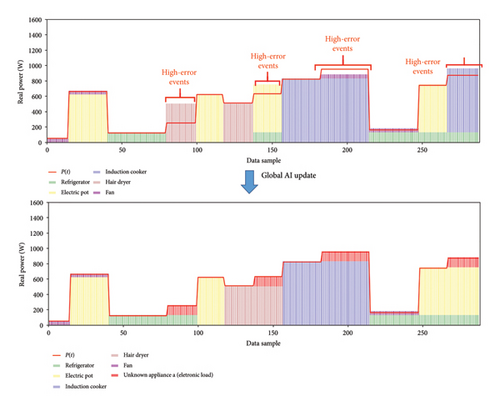
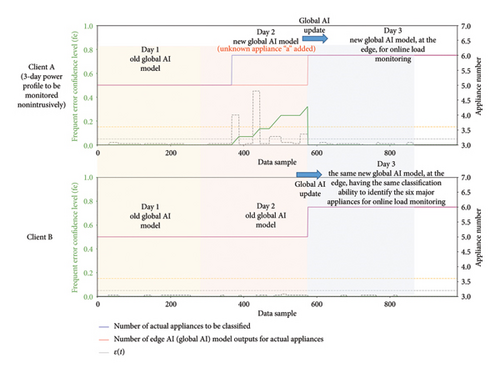
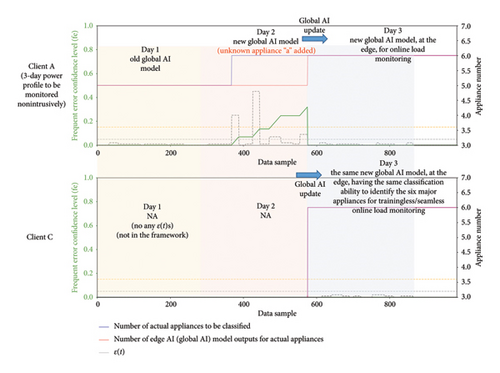
3.3. Discussion
Energy disaggregation, NILM, is essential for understanding consumer power consumption patterns, which can lead to wide consumer-centric applications such as energy conservation and carbon emission reduction for responsible energy utilization and sustainability. The main aim of this study is to propose an active distributed (residential) NILM algorithm integrated with HFL in an edge–cloud collaborative computing framework, which is named Active FedNILM, for energy management. The proposed Active FedNILM algorithm is an algorithmic and systemic innovation in a vanilla edge–cloud computing framework. In an application-oriented perspective, the proposed Active FedNILM algorithm is used to address the training data scarcity while considering the secured transferability at the edge for the smart (residential) mains energy disaggregation application, which is capable of identifying/annotating unknown new/latent electrical appliances through the edge–cloud collaboration with minimal user intervention such that the practicality and applicability of NILM in practice can be improved. Two simulation scenarios have been demonstrated in Section 3: An HEMS with basic active energy disaggregation in a single field of interest has been demonstrated as Scenario 1 in Section 3.1; a distributed HEMS framework with active energy disaggregation implemented over privacy-preserving edge–cloud collaboration across multiple fields of interest for massive load data containing all different appliance classes to be modeled with privacy protection has been demonstrated as Scenario 2 in Section 3.2. The two simulation scenarios are summarized in Table 3. The discussion is made, and this study is summarized here. In Section 3.1, as shown in Figure 10, active energy disaggregation in a single field of interest is achieved; the correct load classification results are obtained through each of the three new global consolidated AI model updates for each of the three frequently appeared new appliances in the field. This is shown in Table 8 as well, which shows the classification evaluation of each of the three new global consolidated AI model updates and indicates the achievement of the final AI model throwing an excellent classification performance level of average F1 score of 0.98 (across all the appliances). In addition, as shown in Table 8 against Table 6 reporting the improvable load classification results obtained in the field conducting basic energy disaggregation, active energy disaggregation combats the data scarcity problem. The specification of the electrical appliances monitored nonintrusively for the first part (Demo 1.1: basic energy disaggregation) and second part (Demo 1.2: active energy disaggregation) of the demonstration (Scenario 1) is listed in Table 4 and Table 7, respectively. Finally, in Section 3.1, referring to Figure 9 (as an illustrative example of the power profile for the field on Day 2) with Figure 10, Figure 11 against Figure 9 shows the correct load classification results after the second new global consolidated AI model update is completed (as shown in Figure 10). In Section 3.2, as shown in Figure 14, according to the proposed Active FedNILM algorithm (refer to Algorithm 3), the two clients, that is, Clients A and B, in the edge–cloud collaboration framework leverage their private load data for building a (new) global consolidated AI/NILM model under the privacy protection so as to achieve online smart active/autonomous (residential) mains energy disaggregation at the edge. The specification of the electrical appliances monitored nonintrusively in each field of Clients A and B that are leveraged in Active FedNILM is listed in Table 9; the specification of the electrical appliance that is newly added and used on Day 2 in the field of Client A is (P, Q) = (130 W, −70 VAR). The correct energy disaggregation results on Day 2 in the field of Client A utilizing the deployed (new) well-trained global consolidated AI model (against the deployed old well-trained global consolidated AI model) are obtained to all the six different types of electrical appliances for their future load identification (the overall classification rate is improved by approximately 11%), as shown in Figure 13 corresponding to Figure 14 that reveals the collaborativeness between the two clients in the framework to build a (new) global consolidated AI/NILM model in Active FedNILM. As reported in Table 11 showing the energy disaggregation data modeling (test) results for Client A, the achieved (new) well-trained global consolidated AI model whose resulting training progress is illustrated in Figure 12 produces an excellent level of average F1 score of 0.93 (across all the six appliance classes). As summarized in Table 12, the collaborativeness between the two clients (Clients A and B) in the framework achieving the classification performance improvements (approximately +11% for Client A and approximately +3% for Client B) through Active FedNILM is also revealed. Finally, a new client, Client C, that joins the framework on Day 3 performs trainingless/seamless/fully nonintrusive online (residential) mains energy disaggregation in its field at the edge, utilizing the (new/newest) global consolidated AI model deployed remotely on its edge gateway to achieve the secured transferability while addressing the data scarcity, as proven in Figure 15 (there are no high-error events produced from misidentifications to the electrical appliances in the field).
As demonstrated in this section, consequently, with the developed active privacy-preserving distributed edge–cloud collaboration mechanism in the proposed framework, the cloud achieving converged computing can assist distributed on-site edge devices, as on-site autonomous edge devices, in identifying unknown new/latent appliances for smart energy disaggregation, and they can perform online autonomous energy disaggregation based on a global consolidated knowledge/AI model established in Active FedNILM and deployed on-site at the edge. The feasibility and effectiveness of the proposed framework with the developed active privacy-preserving distributed edge–cloud collaboration mechanism for smart energy disaggregation have been showcased. The simulation results have shown that it has the potential to be conducted in practical implementations.
4. Conclusions
An effective DSM strategy can alleviate the ever-increasing electricity demand derived from customers in downstream smart grid sectors. Energy disaggregation, which is an EMS software component, is a load monitoring approach that can monitor relevant electrical appliances such that effective DSM can be achieved. Moreover, it is essential for understanding consumer power consumption patterns, which can lead to wide consumer-centric applications including energy conservation and carbon emission reduction. Alongside the currency of the research subject of energy disaggregation/NILM, in this study, an energy management framework implementing an active privacy-preserving and distributed edge–cloud collaborative computing–based energy disaggregation algorithm, which is called Active FedNILM, for performing smart residential mains energy disaggregation at the edge has been proposed, and its preliminary implementation for showcasing its feasibility and effectiveness has also been demonstrated. The proposed framework that can achieve smart residential energy disaggregation, an illustrative application paradigm of the framework, at the edge while considering data privacy preservation and can realize autonomous AI modeling to adapt to load monitoring environments for improved distributed energy disaggregation has an algorithmic and systemic innovation in a vanilla edge–cloud computing framework. As reported from the simulation results showing the feasibility and effectiveness, the overall load classification rate obtained through the smart residential mains energy disaggregation at the edge has been improved maximumly by ∼11%.
As introduced in Section 1, energy disaggregation is an alternative to the ILM methodology, which can enhance the practical applicability of HEMSs for achieving, for instance, effective residential DSM. In addition, it can be dedicated in edge–cloud collaborative computing. As contributed here, the proposed framework has been dedicated in the research subject of energy disaggregation/NILM for energy management in DSM; it demonstrates its application paradigm implementing the active residential mains energy disaggregation algorithm with the edge–cloud collaborative computing mechanism in FL. Therefore, as expected, the work reported in [18, 19] can be advanced by the proposed framework for the practical realization of effective residential DSM. Sustainable smart cities cover a wide range of research subjects such as energy and intelligent transportation that yield significant sustainability benefits by reducing carbon dioxide (CO2) emissions and other harmful pollutants through traffic control and management to vehicles. Similarly, as expected, the work reported in [44] and dedicated to designing and structuring a cyber-physical system with a specific focus on vehicles equipped with on-board diagnosis for data analysis on relevant parameters like engine RPM, vehicle speed, and mass airflow to obtain CO2 emissions and fuel consumption can also be advanced in an edge–cloud collaborative computing manner for the achievement of more sophisticated data science analytics.
Although the proposed framework in this study is a proof-of-concept framework implementation, it represents a considerable step forward in the research subject. In the future, the proposed framework with the active privacy-preserving and distributed edge–cloud collaborative computing–based energy disaggregation algorithm will be validated by some publicly available residential, commercial, and/or industrial NILM datasets [34]. Moreover, a vertical FL (VFL)–based AI algorithm such as PyVertical supporting VFL based on split learning for smart-home electricity data cleaning [45] and/or SecureBoost [46], which is a novel gradient tree-boosting algorithm based on a lossless FL framework, will be developed and integrated as a preceding stage of the presented Active FedNILM scheme to ensure high data quality under data privacy protection. In addition, the presented scheme with the time-series load modeling and forecasting mechanism in [20] can be conducted to, integrated with, and used by the residential community energy management framework in [47] to autonomously and nonintrusively parse required data like appliance energy consumption data and users’ preferences for using different appliances. Finally, the presented scheme, based on FedAVG, to be commercialized will be implemented in either the WISE-PaaS/AIFS (AI Framework Service) solution or FedML (FedML is an open research library and benchmark to (1) build ML models based on distributed datasets over multiple locations and (2) commercialize FL easily, scalably, and economically). In the meanwhile, it can be based on FedProx [48], a version of generalization and reparametrization of FedAVG, to be allowed for more robust convergence than that of FedAVG practically.
Conflicts of Interest
The authors declare no conflicts of interest.
Author Contributions
Yu-Hsiu Lin, Yung-Yao Chen, and Shih-Hao Wei conceived and designed the experiments. Moreover, they contributed the related experimental tools/materials and analyzed the experimental data. In addition, they performed the experiments. The contributed article was written by Yu-Hsiu Lin. Yu-Hsiu Lin, Yung-Yao Chen, and Shih-Hao Wei have read and agreed with the contributed article.
Funding
The National Science and Technology Council, Taiwan, partly supported this research under Grant nos. MOST 111-3116-F-006-005, MOST 111-2221-E-027-050, and MOST 111-3116-F-027-001. The Taiwan Space Agency, Taiwan, partly supported this research as well under Grant nos. NSPO-P-111322 (211P71) and TASA-P-1120345 (212I28). The author acknowledges the financial support received from the “Research Center of Energy Conservation for New Generation of Residential, Commercial, and Industrial Sectors” from The Featured Areas Research Center Program within the framework of the Higher Education Sprout Project (Grant no. T7141101-19) of the Ministry of Education (MOE) in Taiwan.
Acknowledgments
The authors sincerely thank Che-Hao Hsu for his efforts in supporting some of the present work. Mr. Hsu was with the Graduate Institute of Automation Technology, National Taipei University of Technology, Taipei, Taiwan, where he received his M.S. degree in Automation Engineering in February 2024. In addition, the authors would like to express their great appreciation to the reviewers and editors for their invaluable suggestions and comments concerning this research.
Open Research
Data Availability Statement
Data sharing is not applicable to this article as no new data were generated in this study.




